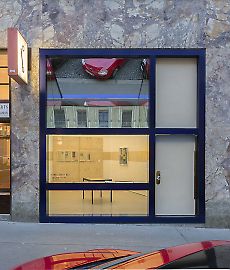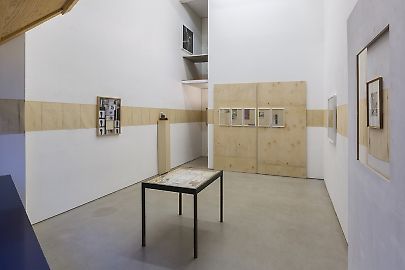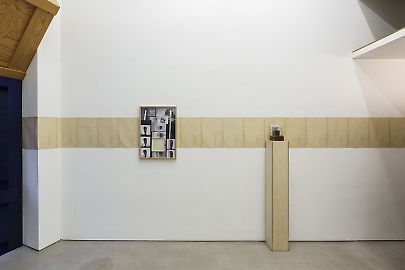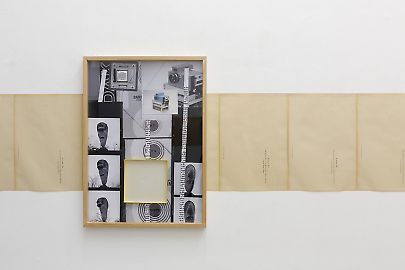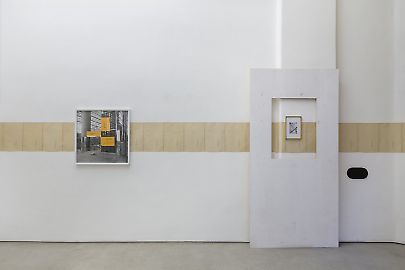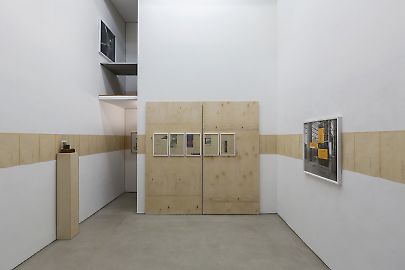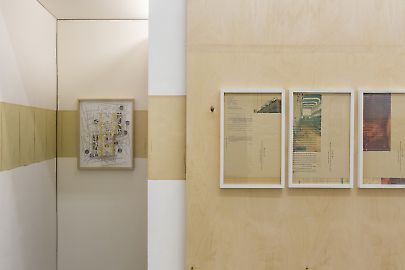Mladen Bizumic -- Kodak: Reorganization Plan
Ausstellungseröffnung: 19.3.2015, 18 bis 21 Uhr
Exhibition dates: March 20 – June 16, 2015
For his second solo exhibition at Georg Kargl BOX, Mladen Bizumic composes a set of works that continue yet another stage of his long-term photographic project dedicated to products of the legendary manufacturer Kodak. Bizumic’s show refers to the recently completed reorganization plan of Kodak.
Founded by George Eastman in 1880, the Eastman Kodak Company, headquartered in Rochester, N.Y marketed the world’s first flexible roll film in 1888 and turned photography into an unexpected popularity with a $1 Brownie camera in 1900. Quickly Kodak became one of the main photography labels in the world and retained its prominence for the entire 20th century. The company's popularity was such that the tagline "Kodak moment" entered the common lexicon to describe a personal event that demanded to be recorded for posterity. In 1964 Kodak commissioned its own pavilion at the New York’s Worlds Fair; in 1976, Kodak had a 90% market share of photographic film sales in the United States; in 1984 the company sponsored the Winter Olympic Games in Sarajevo. After more the 100 years in business Kodak began to struggle financially in the late 1990s as a result of the decline in sales of photographic film and its slowness in transitioning to digital photography, a technology which paradoxically originated from the company’s own laboratory. The first digital camera was invented by Kodak’s engineer Steve Sasson in 1975 but the Board of directors refused to market it due to hugely profitable sales of photographic film. Unfortunately they could not capitalize on their high prized invention. In other words Kodak invented its own „death“. In 2012, after over 130 years in business Kodak filed for Chapter 11 bankruptcy protection and continued to operate while seeking to reorganize its finances. After only 20 months Kodak emerged from the restructuring profitable once again. Under the slogan „What’s next starts now“, Kodak is nowadays refocusing on their own historical strengths: research, development and innovation of the future technologies. In February 2015 the company got the chance to maintain the best of the analogue past by signing a contract with major Hollywood studios to prolong the 35mm colour negative film production for years to come.
Mladen Bizumic’ interest in the history of Kodak company is on the one hand autobiographically provoked by his exclusive use of their photographic films since the age of fifteen but generally driven by the changing perception of the image from the analogue to the digital. Even if the materiality of the image gets increasingly lost in the digital age, the desire and fascination for the physical object still remains. Bizumic is detecting the traces of the materiality of photography by focusing on the „sculptural“ element of the image itself, the chemistry, the paper that it is printed on, the toning as well as the forms of presenting photography, the framing device and the display.
For the Georg Kargl BOX he creates an atmospherically charged installation by revisiting historical moments from Kodak that follow the transformation of the 20th century imaging. Alongside, an original Bakelite US Baby Brownie camera which was extremely popular between two world wars he displays a disassembled 1980ties Kodak Disc Camera 4000, which intended to reach a utopian future that had never arrived. Thus Bizumic is pointing not only at the successes but also the failures.
The historic development of Kodak from the main „photography“ label to the new structured „image“ company does not only mark the way from analogue to digital, from materiality to immateriality but also represents the shift from the industrial to the post-industrial society. Photography should be always understood within their specific context and in the form it is shown. It belongs to the historically specific process of production and to its materiality that implies the sense of the time when it was shot.
By printing the Kodak’s 2013 announcement of the successful emergence from Chapter 11 on aged paper collected in the bankrupt polish ZNTK (Railway Rolling Stock Repair Company) in Poznan, Bizumic is interweaving two different socio-economic systems and temporalities. He draws the attention to the fact that the neo-liberal strategy of reorganization following the Western model played a key role in the process of deindustrialization with far reaching consequences to the economic and cultural impacts on post-communist countries.
The subtle texture paper affects the text and the image printed on and giving the impression of multilayered times. This has an impact on the whole space due to dense paper sheets arranged in a horizontal line around the gallery walls. The arrangement not only creates a cohesive structure of the installation but also gives the illusion of an enlargement of the small, but architecturally remarkable space. By sourcing elements from a relevant past to accentuate the present situation Bizumic manifests his recurrent artistic exploration of time that subtexts his practice and offers the viewer multiple readings of the past and the present and projecting a potential future.
Text: Fiona Liewehr & Mladen Bizumic


